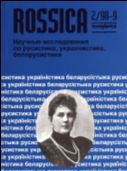Interwar Czechoslovakia and the Emergence of the Rusyn (Ruthenian) Ethnic Identity
Interwar Czechoslovakia and the Emergence of the Rusyn (Ruthenian) Ethnic Identity
Author(s): Kirill ShevchenkoSubject(s): Geography, Regional studies, Cultural Anthropology / Ethnology, Interwar Period (1920 - 1939), Identity of Collectives
Published by: AV ČR - Akademie věd České republiky - Slovanský ústav and Euroslavica
Keywords: Czechoslovakia ; interwar period; Rusyn; Ruthenian; ethnicity;
Summary/Abstract: Rusyn (Ruthenian) movement which is presently on the rise has already refuted quite widespread idea about the final decision of the question of ethnic self-identification of the local East-Slavonic population in Eastern Slovakia and Transcarpathian Ukraine. When after the final collapse of the Communist system imposed from above ethnic self-identification ceased to be the only option more than 50% of Ukrainians living in the Eastern Slovakia rejected their official Ukrainian identity and preferred to identify themselves as Rusyns reviving their traditional ethnic name and set of values. The latest available data from March, 1991 demonstrate that at that time 17,197 inhabitants of the Northern-Eastern region of Slovakia identified themselves as Rusyns while only 13,284 persons indicated themselves as Ukrainians. Speaking about the essence of Ruthenian problem at the time being P.R.Magocsi in his report at the First World Congress of Rusyns which took place in Medzilaborce, March 23-24, 1991 stressed that Rusyns (with one possible exception of the Rusyns in Vojevodina) cannot be still regarded as a separate people but „the question about whether Rusyns have to become a separate original nation or simply a part of any other nation is the essence of so-called „Rusyn problem”. Active work on codification of Rusyn dialects and creation of their own literary language, persistent regeneration of specific Rusyn symbols of the past, strong criticism of the socialist period when the mere existence of Rusyns was completely denied - all these are characteristic features of the modem Rusyn movement. It testifies to the fact that Rusyn mentality in spite of intensive campaign of Ukrainization conducted by both Soviet and Czechoslovak Communists from the beginning of the 1950’s proved to be rather viable and deep-rooted. The character of the present Rusyn movement which upholds the idea of Rusyns as the fourth separate Eastern Slavonic people different from Ukrainians has its roots in the First Czechoslovak Republic. Therefore, the period of the interwar Czechoslovakia in the framework of which separate Rusyn stream had emerged is of crucial importance for understanding the reasons and preconditions of such development. The emergence of the particular Rusyn identity different from both Russophiles and Ukrainophiles was the final outcome of the contradictory and intricate interplay of the numerous political, cultural and social factors as well as some interesting peculiarities of the internal policy of interwar Czechoslovak elite. The most important of these factors will be considered in this article.
Journal: ROSSICA
- Issue Year: IV/1998
- Issue No: 2
- Page Range: 65-79
- Page Count: 15
- Language: English

